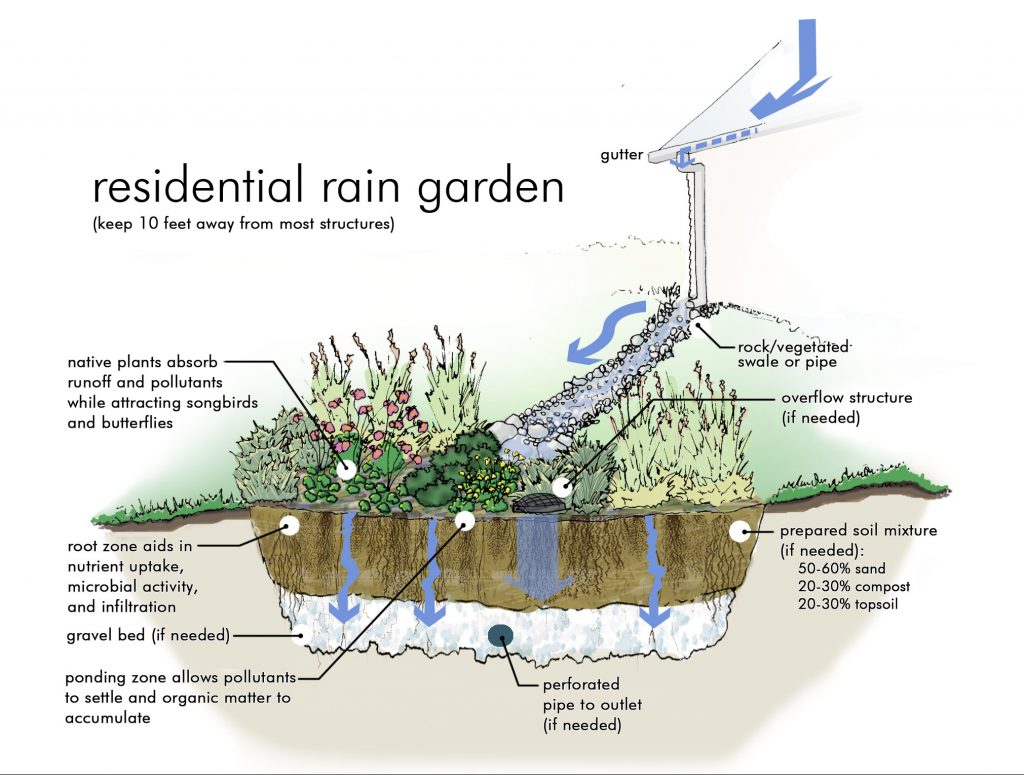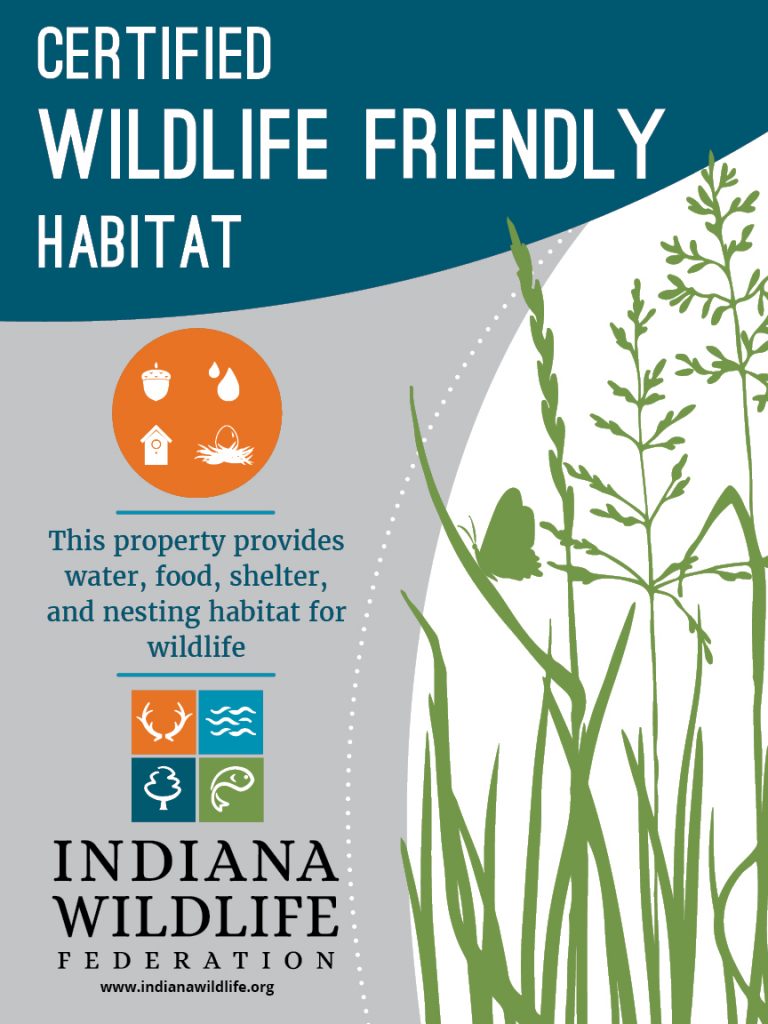Using Native Plants
There are Different Ways to Protect Water with Native Plants
You can use native plants anywhere on your property and capture some of their benefits. This includes foundation plantings and other typical landscape beds. Rain gardens and shoreline plantings, however, are the most impactful.
Rain Gardens
Rain gardens are shallow depressions in a yard that are stocked with native plants and designed to capture and infiltrate stormwater, keeping it from running off the property and polluting our waterways. Often, a structure’s downspouts will be directed into the depression, though they can also catch water from swales or other conveyances. The native plants used in rain gardens tolerate periods of inundation (high water or consistently wet soil) and drought, and their deep roots help filter water as it percolates down into the soil. If designed and built correctly, rain gardens do not hold water long enough to become attractive breeding grounds for mosquitos.

Check out this guide for building a rain garden on your property. There are links to sample planting plans in the sidebar on this page, and a list of native plant suppliers here. Rain gardens do need maintenance to perform optimally, so be sure to review this guide, too.
County Soil and Water Conservation Districts are often great resources for technical assistance. Some may also have funding to help with the installation costs.
Below are some examples of planting plans with plant lists for rain gardens with variations depending on the style of rain garden you desire.
Rain Garden – Attracting Birds & Butterflies
Rain Garden – Low Diversity of Plants
Rain Garden – Short Statured Plants
Rain Garden – Plants that Tolerate Partial Shade
Shoreline Plantings

Shoreline plantings mimic natural conditions by buffering the water’s edge with dense plantings. This helps filter stormwater runoff, stabilize the shoreline itself, and even deter pesky waterfowl like geese. Native plants can also be used in the water itself. The littoral zone is an area of shallow water just off the shore that, when properly planted, provides important habitat for wildlife.
The planning and construction of a simple native shoreline planting can usually be a do-it-yourself project. However in some instances, it may be best to hire a professional. Make sure the contractor is knowledgeable about city or state regulations concerning construction activity around a waterbody (if there are any). The following are all good questions to ask potential candidates to ensure you will be satisfied with their work:
- What experience do you have with native shoreline plantings?
- Are you willing to work with homeowners?
- Are you knowledgeable about local and state requirements or permits?
- Can you help me find an appropriate design for my shoreline?
- Are you experienced in erosion control practices necessary for shoreline plantings?
Check here for a list of Indiana native plant suppliers that can help get you started. Your County Soil and Water Conservation District is also a great source for technical assistance.
Finally, the State of Indiana has developed a great publication that can help you with your shoreline planting – whether you plan to do it yourself or hire a contractor. The Lakescaping for Wildlife and Water Quality: Indiana Addendum contains case studies from around the state as well as information on native plants, cost estimates, and rules and regulations that may apply. The State of Minnesota’s Restore Your Shore Program is another great resource you may find helpful.
Below are some examples of planting plans with plant lists for shoreline plantings with variations depending on the style of shoreline you desire.
Shoreline – Attracting Birds & Butterflies
Shoreline – Low Diversity of Plants
Shoreline – Short Statured Plants
Shoreline – Plants that Tolerate Partial Shade
Shoreline – Above the Seawall
Shoreline – Below the Seawall
Tips and Tricks
Native plants might be a different aesthetic than we’ve become accustomed to. They aren’t your grandmother’s roses! There are a few tricks, however, to taming the ‘wild’ look if you’re hoping to baby step your way into a landscape that does more than just hide the house’s foundation.
Create an Edge
You can use a native grass like Prairie Dropseed to create a border for your planting. You could even use a standard boxwood shrub if a more conservative approach is appropriate. Either way, a clear edge helps convey a sense of purpose.
Create Some Rhythm
Place plants in odd-numbered groups (3-5-7, etc.) and repeating masses. In other words, five purple coneflowers on the left, seven more in the center, and another five on the right. Do this with multiple species to create a sense of rhythm and order through the landscape. You can still use single plants or smaller individual groupings for highlights without spoiling the effect.
Keep It Flowering
Plant lists like this one show each species’ flowering time. Select a range of species that cover the whole growing season. Not only does this provide food and habitat for more wildlife, but it’s hard to complain when there are flowers in the landscaping!
Right Plant, Right Place
If you are trying to keep a more controlled look with your native plants, know which ones are tall and which are short. The tall ones should go in the back of your bed or, if the bed doesn’t have a backside, where they won’t hide smaller plants or fall over the edge. If you’re planting a rain garden, be sure to know which plants tolerate wet feet the best—these go in the bottom of the basin.
Registration

In some cities or towns, it may also be necessary to register your rain garden so as to avoid violating any weed ordinances. In other areas, this may not be necessary, but you might still like to get some recognition for the work you’re doing for our environment. The Indiana Wildlife Federation offers a certification program for backyards, neighborhoods, businesses, schoolyards, and just about any other property. Once a property is certified, the landowner has the option to install a nice sign identifying the area as wildlife-friendly.